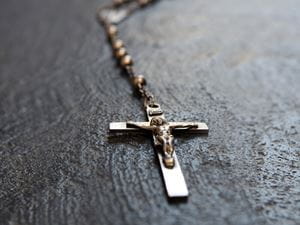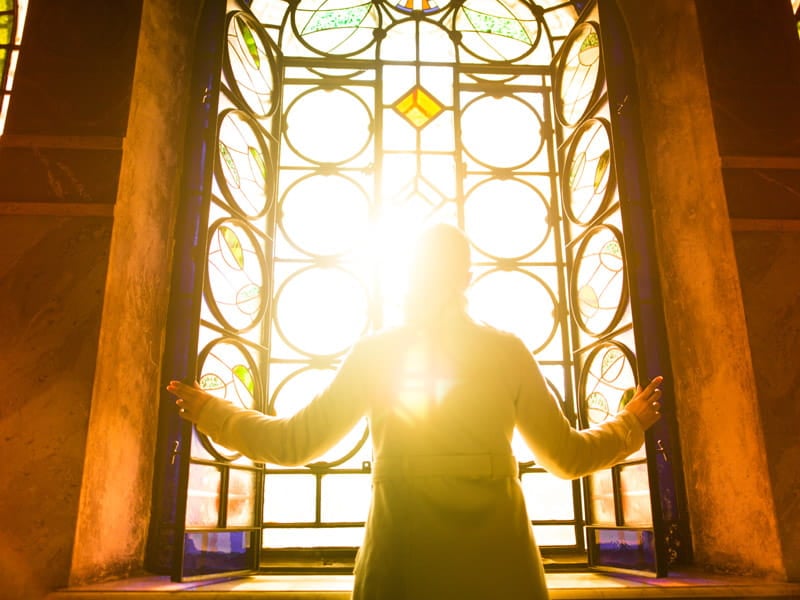
Prayer beads, also referred to as rosary beads, are used in the practice of prayer and meditation. Prayers are repeated a number of times corresponding with the number of beads. Prayer beads are traditionally associated with Catholicism, but their use is widespread with many religious traditions incorporating them.
The history of the rosary in Christian circles can be traced all the way back to the Crusades. It is believed by historians that the Crusaders had adopted this practice from Arabs, who, in turn, copied the observance of using beads from India. Recent archeological findings reveal that the ancient Ephesians made use of such beads in their worship of Diana, also known as Artemis, whose temple was one of the seven wonders of the world (Acts 19:24-41).
Prayer beads are also used by Roman Catholics to help the practitioner keep track of some 180 prayers which may up the rosary. Examples of such prayers are Our Father, Hail Mary and Gloria. In the Catholic Church, the rosary is one of the most cherished prayers. The Rosary is still the easiest ways to acquire the ancient skills of meditative prayer, and it is believed by Catholics to be the most effective way to grain the graces that this way of prayer can obtain.
For Catholics, prayer beads are a powerful prayer of intercession. Praying the rosary is promoted as a means of strengthening one’s faith, resisting evil, growing spiritually, and generally benefiting society.
The word rosary comes from Latin and means a garland of roses, the rose being one of the flowers used to symbolize the Virgin Mary. If you were to ask what object is most emblematic of Catholics, people would probably say, “The Rosary.” Catholics ask the Blessed Mother to bring their prayers to Her Divine Son and plead for His aid. Catholics bring rosary intentions to Mary with the hope that their request will be answered.
The rosary is devotion in honor of the Virgin Mary. It consists of a set number of specific prayers. First are the introductory prayers: one Apostles’ Creed, one Our Father, three Hail Mary’s and one Glory Be.
The first prayer in the Rosary is the Apostles’ Creed. It is called the Apostles’ Creed not because it was composed by the apostles themselves, but because it expresses their teachings. The original form of the creed came into use around A.D. 125, and the present form dates from the 400s.
Protestants, when they say the prayer, refer to the “holy catholic church,” using “catholic” to refer to the universal church, not implying any connection with the Catholic Church, which is based in Rome. This is despite the fact that the term “catholic” was already used to refer to a particular, visible Church by the second century and has already lost its broader meaning of “universal. Despite these differences, Protestants embrace the Apostles’ Creed without reluctance, seeing it as embodying basic Christian truths as they understand them.
The next prayer in the rosary is Our Father or the Pater Noster. This is also known as the Lord’s Prayer. This prayer is even more acceptable to Protestants because Jesus Himself taught it to His disciples. It is given in the Bible in two slightly difference versions, the first referenced in Matthew 6:9-13 and the second referenced in Luke 11:2-4. The one given in Matthew is the one commonly said.
The following prayer in the Rosary is the Hail Mary which is really at the center of the devotion. It is a prayer to Mary. While many Protestants assume it’s unbiblical, it does have roots in Scripture. The prayer begins, “Hail Mary, full of grace, the Lord is with thee.” This is the same greeting the angel Gabriel gave Mary in Luke 1:28.
The basic rosary is made up of 59 beads linked together in the shape of a necklace. Each of the beads on the rosary is intended to have a prayer said while holding the individual bead. Of these beads, 53 are for “Hail Mary’s” to be said on them. The other six are intended for “Our Fathers.” These beads provide a physical method of keeping count of the prayers as the fingers are moved along the beads as the prayers are recited.
The use of prayer beads is not scriptural. In fact, Jesus Himself chastised the religious leaders of His time for repeating their prayers over and over. He told the disciples not to emulate them by using “vain repetitions as the heathens do, for they think they will be heard for their many words” (Matthew 6:7).
While many who use prayer beads today claim that the rosary helps them take the focus off themselves and onto Christ, the question is really one to the efficacy of repeating the same phrases over and over in a mantra-like manner. While there are liturgical churches using prayer beads in prayer, non-liturgical churches do not use them.
There is incredible power in prayer. Our ability to pray to God is an incredible privilege and we are called by our Heavenly Father to communicate with Him bolder. If prayer beads in fact enhance your time and communion with God, then they may be for good use, but if repeating the same prayer over and over again isn’t helping intimate communion with God, the use of prayer beads will not be useful to you.

